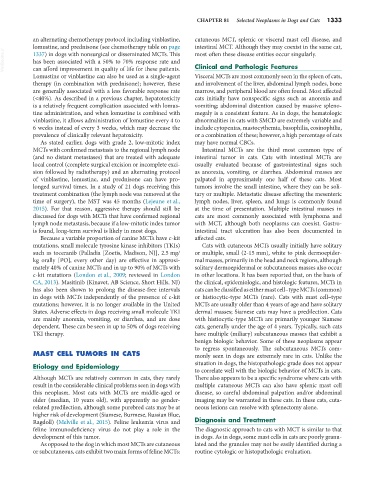Page 1361 - Small Animal Internal Medicine, 6th Edition
P. 1361
CHAPTER 81 Selected Neoplasms in Dogs and Cats 1333
an alternating chemotherapy protocol including vinblastine, cutaneous MCT, splenic or visceral mast cell disease, and
lomustine, and prednisone (see chemotherapy table on page intestinal MCT. Although they may coexist in the same cat,
VetBooks.ir 1337) in dogs with nonsurgical or disseminated MCTs. This most often these disease entities occur singularly.
has been associated with a 50% to 70% response rate and
Clinical and Pathologic Features
can afford improvement in quality of life for these patients.
Lomustine or vinblastine can also be used as a single-agent Visceral MCTs are most commonly seen in the spleen of cats,
therapy (in combination with prednisone); however, these and involvement of the liver, abdominal lymph nodes, bone
are generally associated with a less favorable response rate marrow, and peripheral blood are often found. Most affected
(<40%). As described in a previous chapter, hepatotoxicity cats initially have nonspecific signs such as anorexia and
is a relatively frequent complication associated with lomus- vomiting; abdominal distention caused by massive spleno-
tine administration, and when lomustine is combined with megaly is a consistent feature. As in dogs, the hematologic
vinblastine, it allows administration of lomustine every 4 to abnormalities in cats with SMCD are extremely variable and
6 weeks instead of every 3 weeks, which may decrease the include cytopenias, mastocythemia, basophilia, eosinophilia,
prevalence of clinically relevant hepatoxicity. or a combination of these; however, a high percentage of cats
As stated earlier, dogs with grade 2, low-mitotic index may have normal CBCs.
MCTs with confirmed metastasis to the regional lymph node Intestinal MCTs are the third most common type of
(and no distant metastases) that are treated with adequate intestinal tumor in cats. Cats with intestinal MCTs are
local control (complete surgical excision or incomplete exci- usually evaluated because of gastrointestinal signs such
sion followed by radiotherapy) and an alternating protocol as anorexia, vomiting, or diarrhea. Abdominal masses are
of vinblastine, lomustine, and prednisone can have pro- palpated in approximately one half of these cats. Most
longed survival times. In a study of 21 dogs receiving this tumors involve the small intestine, where they can be soli-
treatment combination (the lymph node was removed at the tary or multiple. Metastatic disease affecting the mesenteric
time of surgery), the MST was 45 months (Lejeune et al., lymph nodes, liver, spleen, and lungs is commonly found
2015). For that reason, aggressive therapy should still be at the time of presentation. Multiple intestinal masses in
discussed for dogs with MCTs that have confirmed regional cats are most commonly associated with lymphoma and
lymph node metastasis, because if a low-mitotic index tumor with MCT, although both neoplasms can coexist. Gastro-
is found, long-term survival is likely in most dogs. intestinal tract ulceration has also been documented in
Because a variable proportion of canine MCTs have c-kit affected cats.
mutations, small molecule tyrosine kinase inhibitors (TKIs) Cats with cutaneous MCTs usually initially have solitary
such as toceranib (Palladia [Zoetis, Madison, NJ], 2.5 mg/ or multiple, small (2-15 mm), white to pink dermoepider-
kg orally [PO], every other day) are effective in approxi- mal masses, primarily in the head and neck regions, although
mately 40% of canine MCTs and in up to 90% of MCTs with solitary dermoepidermal or subcutaneous masses also occur
c-kit mutations (London et al., 2009; reviewed in London in other locations. It has been reported that, on the basis of
CA, 2013). Masitinib (Kinavet, AB Science, Short Hills, NJ) the clinical, epidemiologic, and histologic features, MCTs in
has also been shown to prolong the disease-free intervals cats can be classified as either mast cell–type MCTs (common)
in dogs with MCTs independently of the presence of c-kit or histiocytic-type MCTs (rare). Cats with mast cell–type
mutations; however, it is no longer available in the United MCTs are usually older than 4 years of age and have solitary
States. Adverse effects in dogs receiving small molecule TKI dermal masses; Siamese cats may have a predilection. Cats
are mainly anorexia, vomiting, or diarrhea, and are dose with histiocytic-type MCTs are primarily younger Siamese
dependent. These can be seen in up to 50% of dogs receiving cats, generally under the age of 4 years. Typically, such cats
TKI therapy. have multiple (miliary) subcutaneous masses that exhibit a
benign biologic behavior. Some of these neoplasms appear
to regress spontaneously. The subcutaneous MCTs com-
MAST CELL TUMORS IN CATS monly seen in dogs are extremely rare in cats. Unlike the
Etiology and Epidemiology situation in dogs, the histopathologic grade does not appear
to correlate well with the biologic behavior of MCTs in cats.
Although MCTs are relatively common in cats, they rarely There also appears to be a specific syndrome where cats with
result in the considerable clinical problems seen in dogs with multiple cutaneous MCTs can also have splenic mast cell
this neoplasm. Most cats with MCTs are middle-aged or disease, so careful abdominal palpation and/or abdominal
older (median, 10 years old), with apparently no gender- imaging may be warranted in these cats. In these cats, cuta-
related predilection, although some purebred cats may be at neous lesions can resolve with splenectomy alone.
higher risk of development (Siamese, Burmese, Russian Blue,
Ragdoll) (Melville et al., 2015). Feline leukemia virus and Diagnosis and Treatment
feline immunodeficiency virus do not play a role in the The diagnostic approach to cats with MCT is similar to that
development of this tumor. in dogs. As in dogs, some mast cells in cats are poorly granu-
As opposed to the dog in which most MCTs are cutaneous lated and the granules may not be easily identified during a
or subcutaneous, cats exhibit two main forms of feline MCTs: routine cytologic or histopathologic evaluation.

